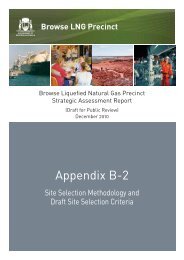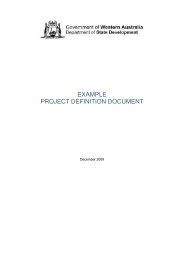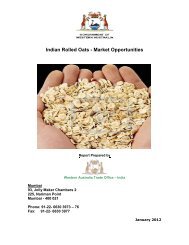Browse LNG Precinct - Public Information Booklet - Department of ...
Browse LNG Precinct - Public Information Booklet - Department of ...
Browse LNG Precinct - Public Information Booklet - Department of ...
You also want an ePaper? Increase the reach of your titles
YUMPU automatically turns print PDFs into web optimized ePapers that Google loves.
<strong>Public</strong> <strong>Information</strong> <strong>Booklet</strong><br />
Size <strong>of</strong> Gas Fields<br />
Question - How much gas is in the fields?<br />
The <strong>Browse</strong> Basin has proven reserves <strong>of</strong> 27.5 trillion cubic feet <strong>of</strong> gas and 600 million<br />
barrels <strong>of</strong> condensate along with probable gas reserves estimated at 60 trillion cubic feet<br />
making it comparable to the Stateís North West Shelf. As a comparison, WA consumes<br />
around 0.3 trillion cubic feet <strong>of</strong> gas per year.<br />
Woodside estimates that the Torosa, Brecknock and Calliance gas fields hold<br />
approximately 14 trillion cubic feet <strong>of</strong> recoverable dry gas and 370 million barrels <strong>of</strong><br />
condensate.<br />
Chemicals<br />
Questions:<br />
� What chemicals are in Woodsideís gas from the <strong>Browse</strong> Basin?<br />
� What will the company do with these chemicals?<br />
� Is there mercury in Woodsideís gas?)<br />
An analysis <strong>of</strong> most naturally occurring resources will show traces <strong>of</strong> 'chemicals'. Many<br />
trace chemicals naturally occur at very low levels in hydrocarbon reserves, including the<br />
<strong>Browse</strong> Basin. Many <strong>of</strong> these trace ëchemicalsí are also found in the natural environment.<br />
Generally these trace ëchemicalsí will remain with the gas or condensate (light oil) and<br />
exported with these products. Some <strong>of</strong> these ëchemicalsí, such as mercury, are removed<br />
and managed in a safe manner. In the case <strong>of</strong> mercury it is sent for recycling and reuse.<br />
Carbon Dioxide<br />
Questions:<br />
� How much carbon dioxide is involved?<br />
� What will the company do with this carbon dioxide?<br />
� How will the company manage and reduce greenhouse gases?<br />
The management <strong>of</strong> broader greenhouse gas emissions is taken very seriously by<br />
industry. For example, this is demonstrated by the Woodside Greenhouse Gas Policy<br />
shown in Appendix 2.<br />
In producing <strong>LNG</strong> there are two major sources <strong>of</strong> carbon dioxide (CO2) which is the main<br />
greenhouse gas.<br />
The first major source <strong>of</strong> greenhouse gas emissions relates to the generation <strong>of</strong> power.<br />
Power is generated in a similar way to a gas fired power station like the one in Broome,<br />
but larger. The exact amount <strong>of</strong> CO2 will depend on the design <strong>of</strong> the <strong>LNG</strong> plant but<br />
would be less than 17 million tonnes <strong>of</strong> CO2 per annum for the production <strong>of</strong> 50 million<br />
tonnes <strong>of</strong> <strong>LNG</strong> per annum and less than 3.8 million tonnes <strong>of</strong> CO2 per annum for the<br />
production <strong>of</strong> 11 million tonnes <strong>of</strong> <strong>LNG</strong> per annum.<br />
5279225 81









